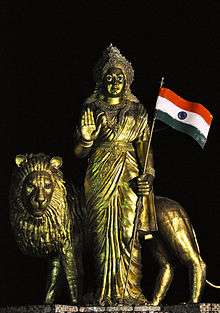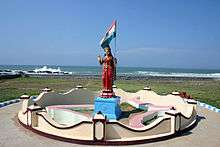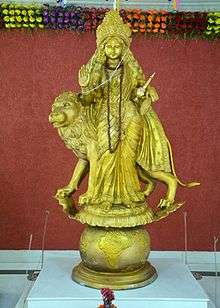Bharat Mata




Bhārat Mātā (Hindi, from Sanskrit भारत माता, Bhārata Mātā), Mother India, or Bhāratāmbā (Sanskrit: भारताम्बा; अम्बा ambā means 'mother') is the national personification of India as a mother goddess.[1] She is an amalgam of all the goddesses of Indian culture and more significantly of goddess Durga. She is usually depicted as a woman clad in a saffron sari holding the Indian national flag, and sometimes accompanied by a lion.[2]
Historic perspective
The image of Bhāratmātā formed with the Indian independence movement of the late 19th century. A play by Kiran Chandra Bannerjee, Bhārat Mātā, was first performed in 1873.[3] Bankim Chandra Chattopadhyay's in 1882 wrote a novel Anandamath. introduced the hymn "Vande Mātaram",[4][5] which soon became the song of the emerging freedom movement in India.
Bipin Chandra Pal elaborated its meaning in idealizing and idealist terms, along with Hindu philosophical traditions and devotional practices. It represented an archaic spiritual essence, a transcendental idea of Universe as well as expressing Universal Hinduism and nationhood.[6]
Abanindranath Tagore portrayed Bhārat Mātā as a four-armed Hindu goddess wearing saffron-colored robes, holding the manuscripts, sheaves of rice, a mala, and a white cloth.[7] The image of Bharatmata was an icon to create nationalist feeling in Indians during the freedom struggle. Sister Nivedita, an admirer of the painting, opined that the picture was refined and imaginative, with Bharatmata standing on green earth and blue sky behind her; feet with four lotuses, four arms meaning divine power; white halo and sincere eyes; and gifts Shiksha-Diksha-Anna-Bastra of motherland to her children.[8]
Famous Indian Independence activist Subramania Bharati saw Bharat Mata as the land of Ganga.He identified Bharat Mata as Parashakti.[9]He also says that he has got the dharsan of Bharat Mata during his visit with his guru Sister Nivedita .
Significance
In the book Everyday Nationalism: Women of the Hindu Right in India, Kalyani Devaki Menon argues that "the vision of India as Bharat Mata has profound implications for the politics of Hindu nationalism" and that the depiction of India as a Hindu goddess implies that it is not just the patriotic but also the religious duty of all Hindus to participate in the nationalist struggle to defend the nation.[10] This association with Hinduism has caused controversy with India's religious minorities, especially its Muslim population.[11]
The motto Bharat Mata ki Jai’ ("Victory for Mother India") is used by the Indian Army.[12]
Bharat Mata temples
At Varanasi

The temple is located in the Mahatma Gandhi Kashi Vidyapeeth campus in Varanasi.[13] The temple houses a marble idol of Bharat Mata along with a marble relief map of India.[13][14]
The Temple, a gift from the nationalists Shiv Prasad Gupta and Durga Prasad Khatri, was inaugurated by Mahatma Gandhi in 1936.[13] Mahatma Gandhi said, "I hope this temple, which will serve as a cosmopolitan platform for people of all religions, castes, and creeds including Harijans, will go a great way in promoting religious unity, peace, and love in the country."[15]
At Haridwar
The temple was founded by Swami Satyamitranand Giri on the banks of the Ganges in Haridwar. It has 8 storeys and is 180 feet tall.[16] It was inaugurated by Indira Gandhi in 1983.[16] Floors are dedicated to mythological legends, religious deities, freedom fighters and leaders.[16]
At Kolkata
The temple is located in Michael Nagar on Jessore Road, barely 2 km away from the Kolkata Airport. Here, Bharat Mata (the Mother Land) is portrayed through the image of 'Jagattarini Durga'. This was inaugurated on October 19, 2015 (Mahashashti Day of Durga Puja that year)[17] by Shri Keshari Nath Tripathi, the Governor of West Bengal. The initiative to build the temple, which has been named 'Jatiya Shaktipeeth', was taken by the Spiritual Society of India in order to mark the 140th Anniversary of 'Vande Mataram', the hymn to the Mother Land.

See also
References
- ↑ "History lesson: How 'Bharat Mata' became the code word for a theocratic Hindu state".
- ↑ Visualizing space in Banaras: images, maps, and the practice of representation, Martin Gaenszle, Jörg Gengnagel, illustrated, Otto Harrassowitz Verlag, 2006, ISBN 978-3-447-05187-3
- ↑ "Far from being eternal, Bharat Mata is only a little more than 100 years old".
- ↑ "A Mother's worship: Why some Muslims find it difficult to say 'Bharat Mata ki jai'".
- ↑ Kinsley, David. Hindu Goddesses: Vision of the Divine Feminine in the Hindu Religious Traditions. Motilal Banarsidass, New Delhi, India. ISBN 81-208-0379-5. pp. 181-182.
- ↑ Producing India, Manu Goswami, Orient Blackswan, 2004, ISBN 978-81-7824-107-4
- ↑ Specters of Mother India: the global restructuring of an empire, Mrinalini Sinha, Zubaan, 2006, ISBN 978-81-89884-00-0
- ↑ The Goddess and the Nation: Mapping Mother India, Sumathi Ramaswamy, Duke University Press, 2010, ISBN 978-0-8223-4610-4
- ↑ http://www.hvk.org/2010/0810/31.html
- ↑ Kalyani Devaki Menon, Everyday Nationalism: Women of the Hindu Right in India: The Ethnography of Political Violence, University of Pennsylvania Press, 2009, ISBN 978-0-8122-4196-9, p. 89f.
- ↑ "Patriotism in India: Oh mother: A nationalist slogan sends sectarian sparks". The Economist. 9 April 2016. Retrieved 9 April 2016.
- ↑ Vinay Kumar (2 October 2012). "It is Jai Hind for Army personnel". The Hindu. Chennai, India. Retrieved 8 October 2012.
- 1 2 3 IMPORTANT TEMPLES OF VARANASI, varanasi.nic.in
- ↑ http://web.archive.org/web/20110211043538/http://varanasicity.com/temples/bharatmata-mandir.html
- ↑ Eck, Diana L (27 March 2012), India: A Sacred Geography, Potter/TenSpeed/Harmony, pp. 100–, ISBN 978-0-385-53191-7
- 1 2 3 Bharat Mata Temple, mapsofIndia.com
- ↑ Bharat Mata Mandir
External links
-
 Media related to Bharat Mata at Wikimedia Commons
Media related to Bharat Mata at Wikimedia Commons - Patriotic fervour The Hindu, August 17, 2003.
- The life and times of Bharat Mata Sadan Jha, Manushi, Issue 142.
- Bharat Mata Images Prof. Pritchett, Columbia University
